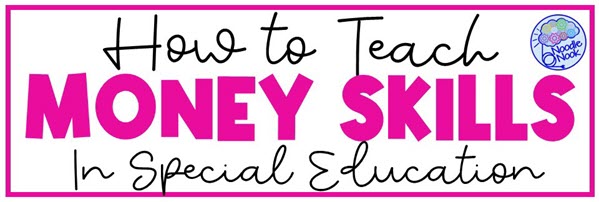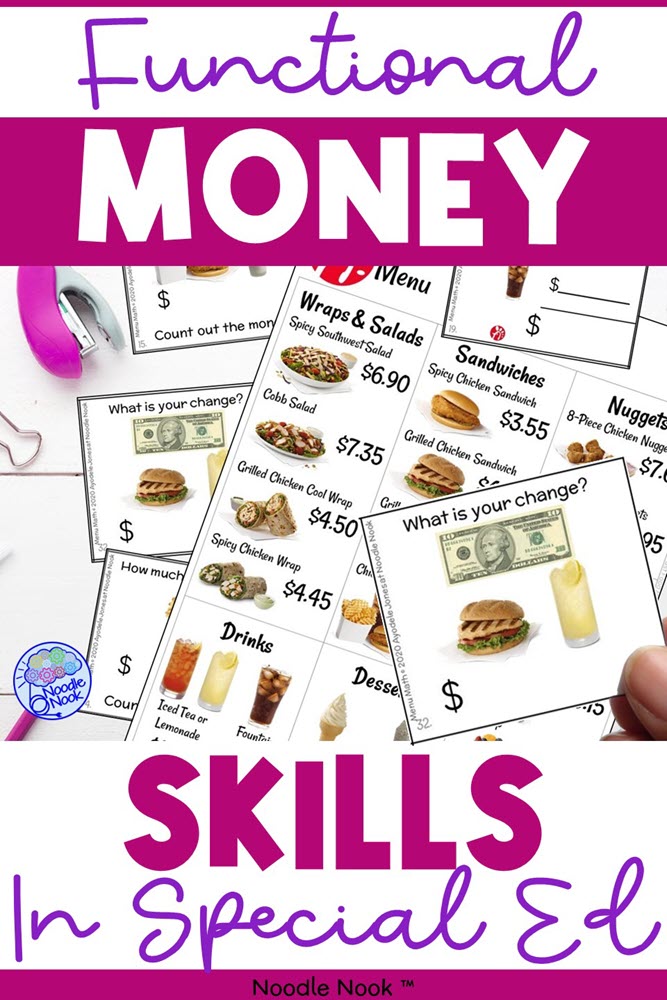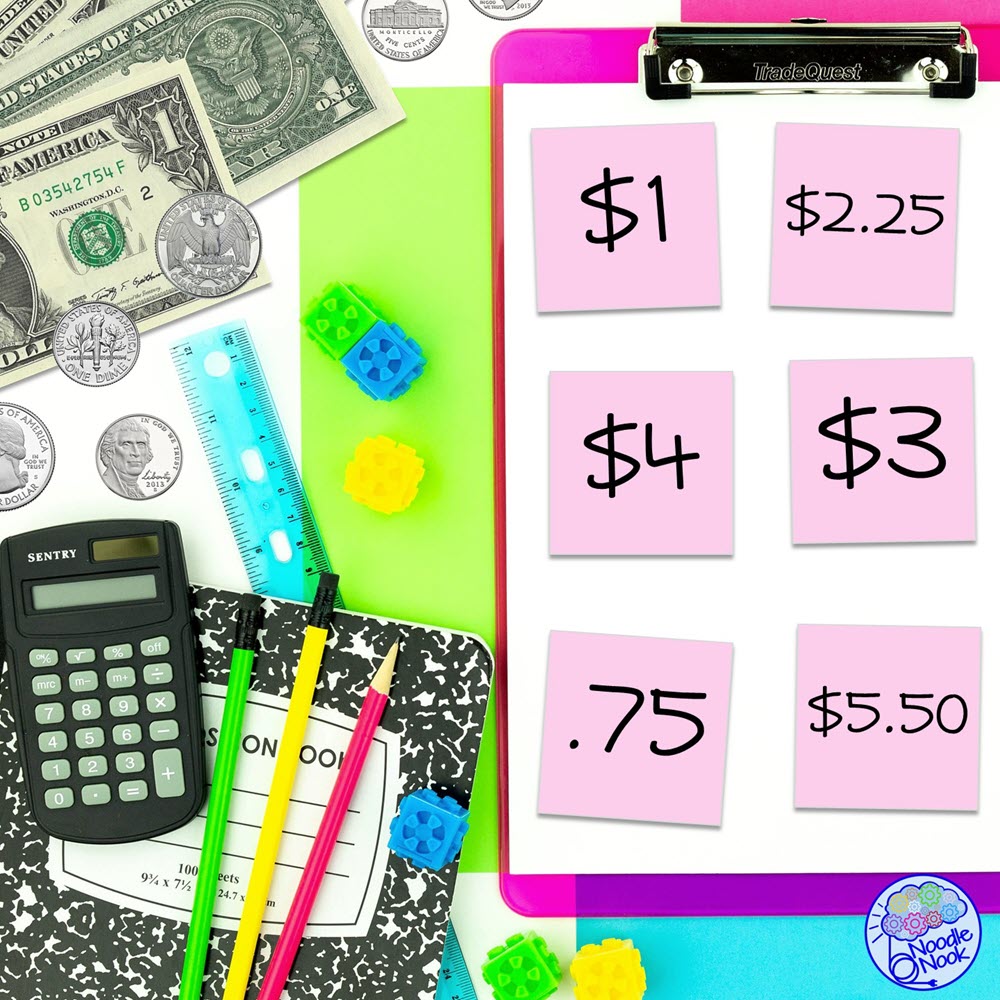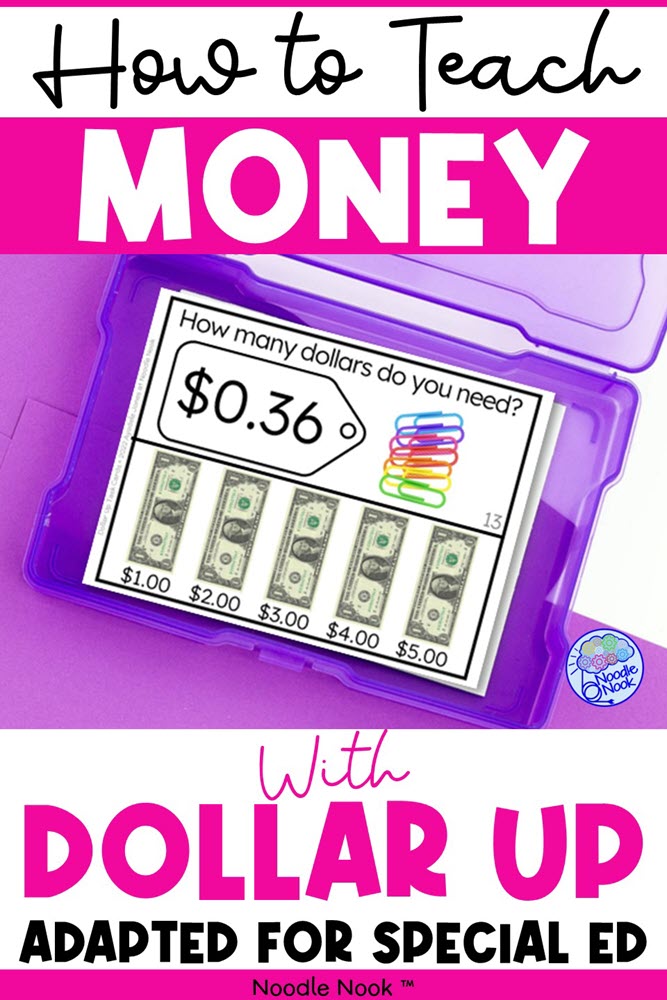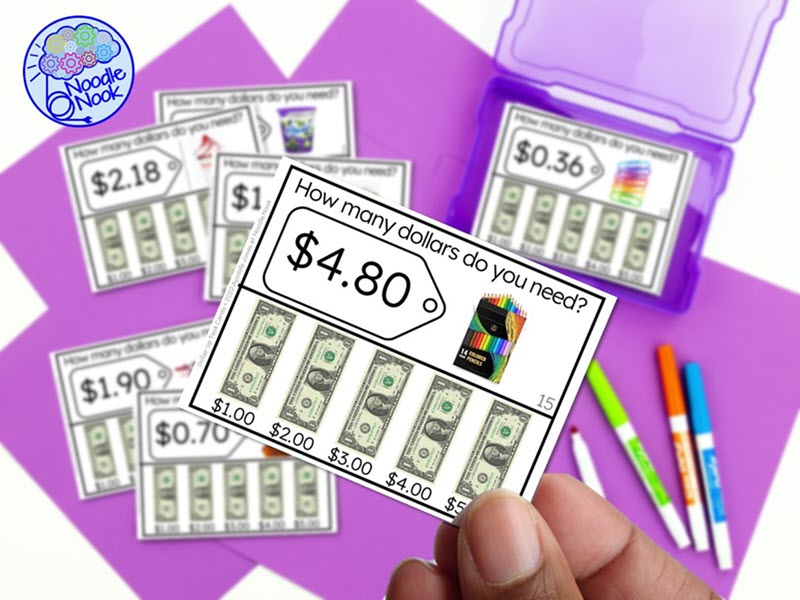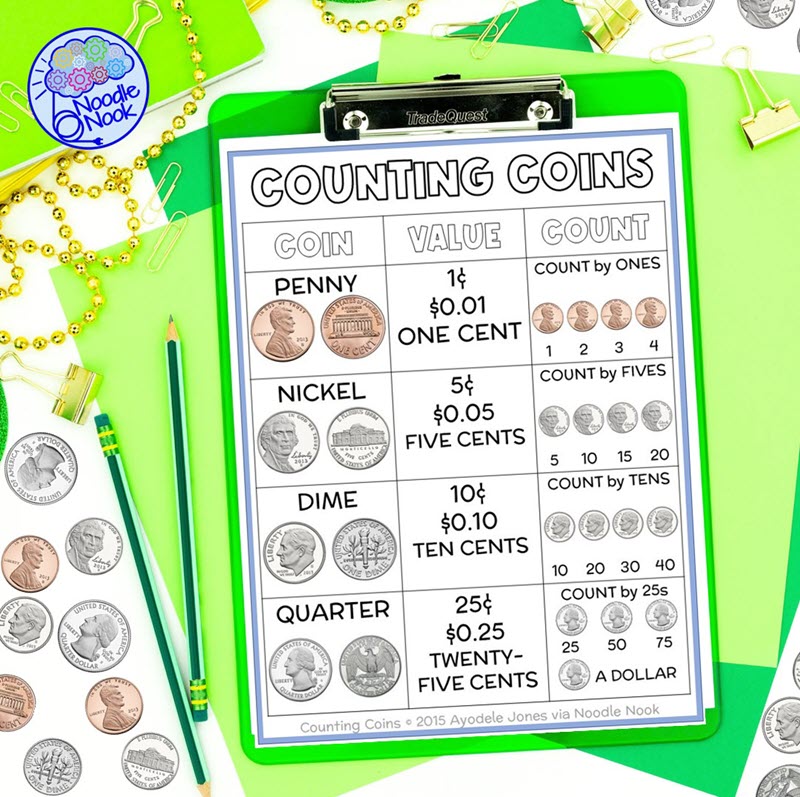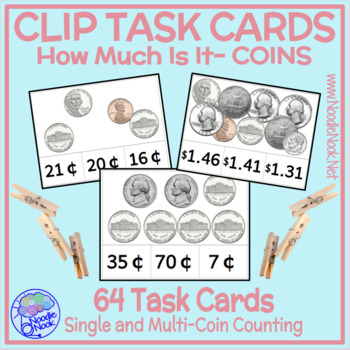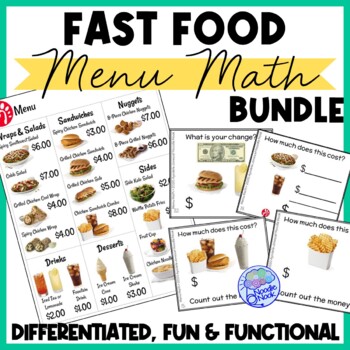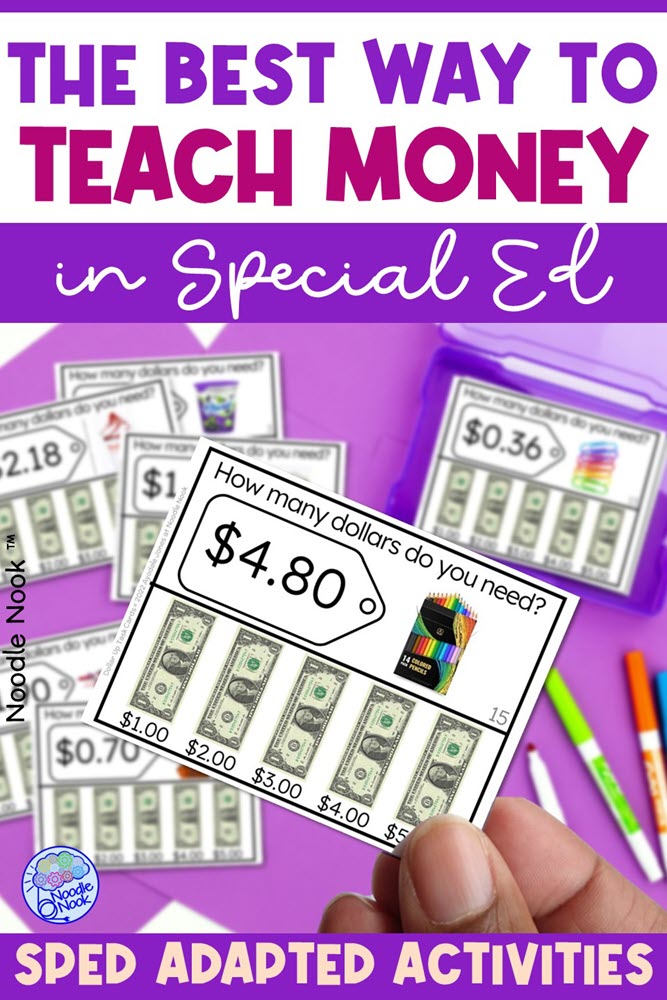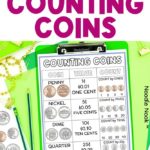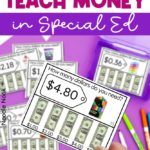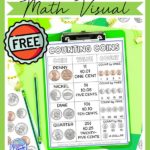How to Teach Money Skills in Special Education
For students with significant disabilities, being able to count and manage money is critical… but how do you teach money skills in special education? First things first, if you are teaching in an Autism unit, a self-contained special education classroom, or in an inclusion model with general education, there’s one thing you have to do.
You have to make time for practicing money skills in addition to the regular math curriculum.
Truth of the matter is our students often spend too little time working on functional math skills or too much time focused on a single IEP goal. It’s essential that we schedule time for independent practice of money skills as well make progress in the regular math curriculum. Just keep that in mind.
How Do You Teach Counting Money
When it comes to HOW to teach money skills to students with disabilities, there is logical progression of skills.
Master the Fundamentals
First, it’s essential to set a student up for success by helping them master the fundamentals. That means mastering 1:1 correspondence and rote counting (up to 5, 10, 20 and beyond). Notice that students don’t necessarily need to master rote counting beyond 100 to Start learning how to count money. As soon as a student is able to wrote count to 5, you can, and SHOULD, start to address money skills.
Then target coin/bill identification (the names of the coins and bills) as well as the values of each. Now, a note here for those of you stuck on a “naming coins” IEP goal you’ve rolled over for the last 2 years:
Knock It Off!
Yup, you heard me. Although naming coins is important, it’s not critical to learning how to count money. Granted, it does make things easier to call out a coin name, but in the real world, it’s not critical. Think about it;
When was the last time you were at the checkout and the cashier said “Your total is 5 dollars, two quarters and 3 pennies”?
Never.
Start Money Skills Early
Getting to work on money skills is something that should happen as soon as a student is able to target any math skills. Use money as manipulatives when you teach one to one correspondence. Use money as a discrimination task so students are familiar with them. Use money as often as possible to help students understand other math skills (even measuring objects with dollar bills).
Exposure is key.
Consider Starting with Dollars
AND to help master the fundamentals, start with dollars first for students who learn skills slowly. I know, seems counter intuitive, doesn’t it? Don’t students have to master coins to move on to bills?
Well, no. They don’t.
You can teach students bills and then at master teach that coins are part of bills and a lot of coins add up dollars. Here’s why: We need to use bills to pay in the real world. Right? You aren’t paying for your groceries with nickels and dimes. At least I hope not.
Most people use bills as their primary cash transaction currency over lots of coins. So, when possible and appropriate, start with bills and save coins for later.
Mastering 1:1 correspondence to 5 and starting to work on the values of coins and bills means it’s time to target money math for your special education students. Here’s how…
How to Teach Money Skills in Special Education
Here are the 5 steps to effectively teach money skills to students with disabilities. There is no magic here. You need to model for the student how to do each skill. Have students participate in guided practice. Finally, you’ll have the students practice independently. Here are the 5 steps:
- Start with Whole Dollar Amounts.
- Focus on Dollar Up Skills
- Teach Skip Counting
- Embed Use of Visual Supports
- Practice with Real World Money Activities for easy Generalization
Start with Whole Dollar Amounts.
Once your students are able to rote count to 5, you can start to work on money skills with whole dollar amounts.
We are targeting a student being able count up using money. It’s also important they start understanding the idea of adding and subtracting.
Finally, we want them to transact with whole dollar amounts.
ACTIVITIES: As a quick and easy activity, have students buy school supplies from you in your “store”. Grab some pencils, paper clips, erasers, and whatever else is within arm’s reach. Then grab a pack of sticky notes and a marker. Make a few ‘price tags’ by writing numbers on the stickies and place them next to each item. Then hand the student a stack of ones. IEP GOAL: When presented with values to the whole number, student will count out the appropriate amount using dollar bills.
And this is an easy activity to make more challenging for students as their skills develop. Add coins or take the value above five dollars. Either way, it’s easy and effective.
Focus on Dollar Up Skills
Once a student gets to independence and mastery of whole dollar transactions, start to throw in dollar up math.
What is dollar up math?
Dollar Up Math is the ability to round up an amount to the next dollar. In the real world, you do this all the time.
If something is $3.75, you dollar up to $4 so you can easily add numbers, budget your purchases, or just know how many dollars to hand the cashier.
Teaching Dollar Up to Students with Disabilities
When you’re teaching dollar up to students with disabilities, you’ll ask them to count out the whole dollar amount (ex: $2.50 needs two dollars), and then tell them to give one more (put down one extra dollar).
It’s that easy. Some student (and teachers too) get bogged down with a student needing to name the strategy, the bills, or even count independently. Truth is, in the real world, all you need to do is
- Identify the total’s whole number.
- Use 1:1 correspondence to count it out.
- Then add one more dollar.
This is an important skill for students who are learning how to do math with money. They need this functional math skill in the real world to have some level of independence. Plus, it’s important for students with disabilities to continue learning money skills to support their post-secondary goals (*ding, ding… IEP designation*).
ACTIVITIES: Use a dollar up mat to teach students with disabilities how to dollar up.
Better yet, use these dollar up task cards to work on dollaring up on totals up to $5.00.
The dollar mat is embedded into the task cards, making it easy for students to visualize and practice.
Teach Skip Counting
Honestly, most students with significant disabilities will have the functional skills they need to transact in cash in the real world with the skills listed above. BUT, that doesn’t mean we stop. Continue to teach money skills to students in special education by working on skip counting.
Skip counting by 5s is the most critical of them all. You can count tens, twenties, dimes, and quarters if you can skip count by fives. It’s also a skill that supports telling time. So, as you start to work on skip counting, use the learning strategies that work best for the student.
Those learning strategies may include using songs and rhymes to make skip counting sing-songy. It may include using manipulatives to rote count and understand sets of five. It may be flashcards or speed drills for review. Whatever the strategy, target skip counting by five as the next stage in money instruction for your special education students.
Embed Use of Visual Supports
You knew this one was coming, right? Students learn with visuals and hands on activities. That’s that works in special education and any education. Add a visual aid to help students understand how money relates, how to skip count, and even the names and values of coins.
I have this easy printable for you to use to do just that.
Be specific on how you want to help a student when you choose visuals. Also, consider how some supports need to be taught in order to be used effectively.
Don’t just slap a printable down like *BAM* and then walk away.
Model, practice, and then practice some more.
Final note on visual supports. For students with significant disabilities, sometimes those visual supports are permanent supports. In other words, a student can only do the skill with the support always present. That’s okay.
If a student needs a counting mat to be successful, GREAT! We know what they need to be successful and they have the capacity to be successful.
Yipee!
Now we just have to figure out a way to make that support available for them in real world settings. We also need to make sure that support is real-world appropriate. We don’t want a 25-year-old person with a disability counting their money on a Paw Patrol dollar up mat because that’s what he learned on. Consider the appropriateness of the visuals as students transition to older grades and the post-secondary.
Practice with Real World Money Activities for Easy Generalization
Students with disabilities will need regular practice with their money skills in order to reinforce skill acquisition. That practice will also help students get to mastery and generalize beyond the classroom. In order to do that and keep it fresh, be consistent with using a variety of engaging real-world activities at independent centers or work stations during math time.
If you’re looking for materials that are fresh, engaging, and mirror real world situations, check out these resources.
What is the best way to teach money?
There you have it. When it comes to HOW to teach money skills to students with disabilities, there are five simple steps. Before you begin, start with some solid prerequisite skills, like being able to rote count to 5. Then follow the five steps:
1: Start with Whole Dollar Amounts; 2: Focus on Dollar Up Skills; 3: Pre-Teach Skip Counting; 4: Embed Use of Visual Supports; and 5: Practice with Real World Money Activities for Easy Generalization.
Be sure to use materials that are similar to real world situations so skills meet a student’s functional goals and needs.
Keep it fresh, fun, and functional and you’ll be successful at teaching students money skills in the classroom.

